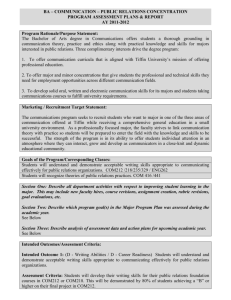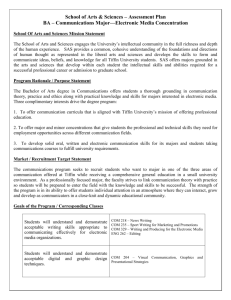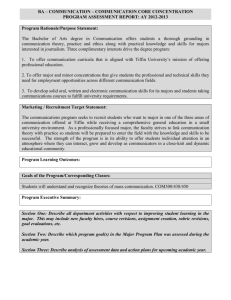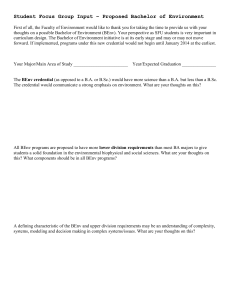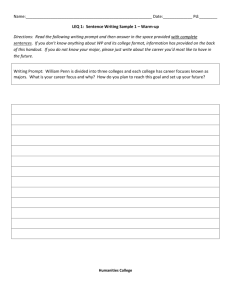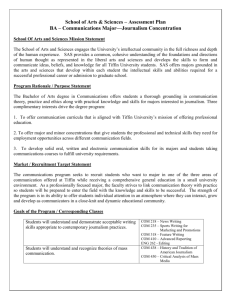BA * COMMUNICATION * ELECTRONIC MEDIA CONCENTRATION
advertisement
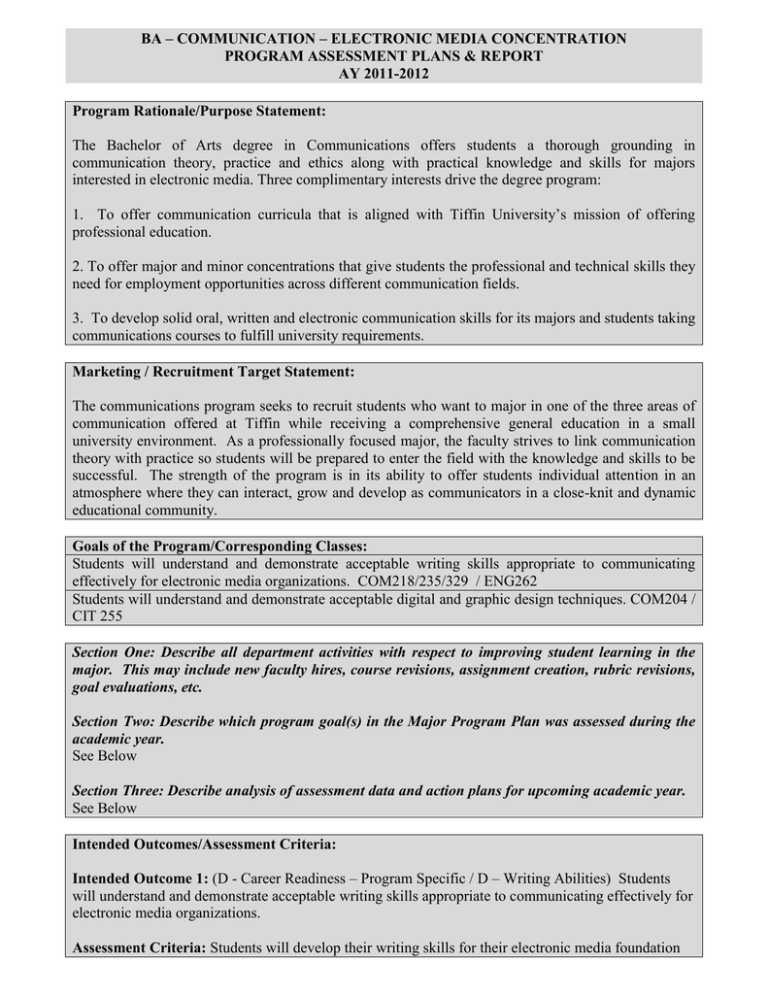
BA – COMMUNICATION – ELECTRONIC MEDIA CONCENTRATION PROGRAM ASSESSMENT PLANS & REPORT AY 2011-2012 Program Rationale/Purpose Statement: The Bachelor of Arts degree in Communications offers students a thorough grounding in communication theory, practice and ethics along with practical knowledge and skills for majors interested in electronic media. Three complimentary interests drive the degree program: 1. To offer communication curricula that is aligned with Tiffin University’s mission of offering professional education. 2. To offer major and minor concentrations that give students the professional and technical skills they need for employment opportunities across different communication fields. 3. To develop solid oral, written and electronic communication skills for its majors and students taking communications courses to fulfill university requirements. Marketing / Recruitment Target Statement: The communications program seeks to recruit students who want to major in one of the three areas of communication offered at Tiffin while receiving a comprehensive general education in a small university environment. As a professionally focused major, the faculty strives to link communication theory with practice so students will be prepared to enter the field with the knowledge and skills to be successful. The strength of the program is in its ability to offer students individual attention in an atmosphere where they can interact, grow and develop as communicators in a close-knit and dynamic educational community. Goals of the Program/Corresponding Classes: Students will understand and demonstrate acceptable writing skills appropriate to communicating effectively for electronic media organizations. COM218/235/329 / ENG262 Students will understand and demonstrate acceptable digital and graphic design techniques. COM204 / CIT 255 Section One: Describe all department activities with respect to improving student learning in the major. This may include new faculty hires, course revisions, assignment creation, rubric revisions, goal evaluations, etc. Section Two: Describe which program goal(s) in the Major Program Plan was assessed during the academic year. See Below Section Three: Describe analysis of assessment data and action plans for upcoming academic year. See Below Intended Outcomes/Assessment Criteria: Intended Outcome 1: (D - Career Readiness – Program Specific / D – Writing Abilities) Students will understand and demonstrate acceptable writing skills appropriate to communicating effectively for electronic media organizations. Assessment Criteria: Students will develop their writing skills for their electronic media foundation courses in COM329. This will be demonstrated by 80% of students achieving a “B” or higher on their final project in COM329. Section One - Activity Statement: This year the communications program taught 16 sections of COM 130: Introduction to Speech Communication, serving approximately 350 students as part of the university's general education core. Ten other basic and advanced courses were offered as part of communication core and concentrations, including: COM 134 COM 212 COM 218 COM 241 COM 310 COM 325 COM 325 COM 318 COM 330 COM 410 COM 438 Digital Photography Intro to Public Relations News Writing Intro to Mass Communication Human, Interpersonal, and Small Group Communication Public Relations Cases, Campaigns, and Non Profits Sports Writing for Marketing and Promotion Feature Writing Video Production Advanced Reporting History and Tradition of American Journalism In keeping with developments in the field of communication and the evolution of Internet technologies, a new course in social media was created and taught as a special topic Spring semester. COM 390 Social Media Extra Curricular Activities included: The publication of editions of the Campus Newspaper. The Communication Club was active on campus and sponsored a number of activities, including a panel of industry practitioners during Fall semester. The club inducted four new members into the National Communication Honor Society of Lambda Pi Eta (LPH) and remained an active student chapter of the Public Relations Student Society of America. Communication Faculty supervised: Three Master of Humanities Thesis Projects Four Internships Two Independent Studies The communication major continues to be the second most popular major in the School of Arts and Sciences. Section Two - Results of Outcomes Activity: 2011-2012 Met/Not Met Data Details COM 329 Not Met Only 44% (8 of 18) students received a “B” or higher on Assignment #10, which was the final assignment. This percentage was skewed by a number of students (graduating seniors) who did not turn in the assignment. Of those who turned in the assignment (8 of 14) 57% scored a “B” or higher. Section Three - Analysis and Action Plans: The percentage of students scoring a “B” or higher on the final assignment was not as high as expected. This may have been because the final assignment was not representative of the other assignments in this writing intensive course. Overall, 66% of the students in the course earned a “B” or higher as their final grade. The deterioration of writing skills among freshmen entering college has been well documented. This year’s assessment may reflect this larger problem. Media courses in the communication program will need to continue to stress the importance of good writing in preparing graduates for careers in the three concentrations. Intended Outcome 2: (D - Technical Proficiency / D - Career Readiness) Students will understand and demonstrate acceptable digital and graphic design techniques. Assessment Criteria: Students will develop their digital and graphic design techniques in COM204. This will be demonstrated by 80% of students achieving a “B” or higher on their final project in COM204. Section One - Activity Statement: COM 204 Visual Communication, Graphics and Presentation Strategies was not taught last year. Section Two - Results of Outcomes Activity: 2011-2012 Met/Not Met Data Details NA Section Three - Analysis and Action Plans: NA Updated: November 2011
